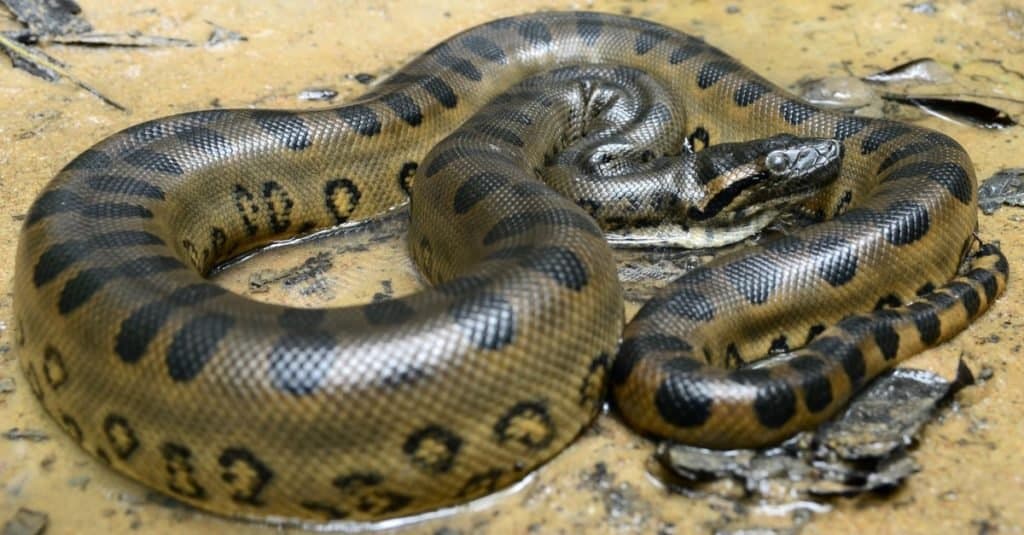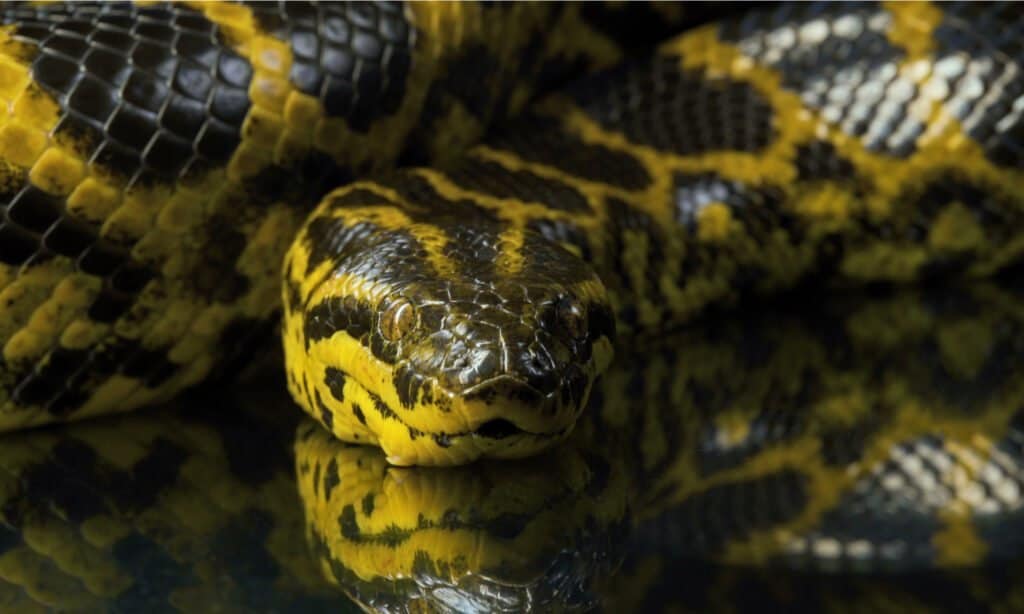The very word “anaconda” instantly strikes fear into the hearts and minds of people all over the world, and for plenty of good reasons! These unique snakes are absolutely massive–some of the largest in the world, in fact–and they’re fearsome predators capable of taking down animals as large as deer, wild boars, and even jaguars. But how many different types of anaconda snakes are there?
Furthermore, what kinds of traits make a snake an anaconda? How are the different types of anacondas similar, and how are they different from one another? Let’s take a closer look below.
What is an Anaconda?

The green anaconda is one of the largest snakes in the world.
©Patrick K. Campbell/Shutterstock.com
“Anaconda” seems to be one of those terms (similar to “viper” or “python”) that many of us casually throw around to describe just about any large, scary-looking snake. However, within a scientific context, “anaconda” refers to a specific type of snake within the Boidae family.
The Boidae family of snakes, as you might have guessed, includes all known boa species. This means anacondas are technically boas, making them fairly closely related to snakes like the boa constrictor and emerald tree boa.
In this group, there are a whopping 49 species of boid snakes spanning 12 different genera. One of these genera, the genus Eunectes, contains all known anaconda species, of which there are currently four: the green anaconda, yellow anaconda, dark-spotted anaconda, and Bolivian anaconda. Here they are in a simple graph to get you acquainted with them:

All four anaconda species share the following traits:
- A semi-aquatic lifestyle. Anacondas are extremely skilled swimmers. They primarily live in low wetlands and swamps throughout South America’s hottest and most humid regions. Interestingly, the term “Eunectes” comes from ancient Greek and loosely translates to “good swimmer!”
- No venom. Like other boas, anacondas are nonvenomous.
- Very long, bulky bodies. Anacondas are among the largest and longest snakes in the world! The green anaconda in particular is the world’s heaviest snake and can reach over 15 feet in length.
- Strong muscles to constrict prey. Since they are nonvenomous, anacondas must take down their prey by suffocating them via constriction.
- Flexible jaws to swallow very large prey. Also like most other boas, anacondas have elongated bones in their skulls. This trait allows the snakes’ jaws to open very wide.
- Habitats located in South America. All four anaconda species live in hot, low-lying swamps throughout South America. This includes much of Brazil, Colombia, Venezuela, and Argentina.
1. The Green Anaconda: Eunectes murinus

Green anacondas can grow to be more than 15 feet long.
©cellistka/Shutterstock.com
The largest and most well-known anaconda species within the Eunectes genus is most certainly the green anaconda. It is widely considered to be the heaviest snake in the world as well as one of the longest. In fact, it’s fairly common for these massive serpents to weigh over 200 pounds and reach lengths exceeding 15 feet!
True to its name, the green anaconda is predominantly a dull olive green in color with round, fairly uniform brown and black spots throughout. The body is very bulky, long, and muscular, even in juveniles. Because its body is so large, it digests food very slowly and is quite slow-moving in general as far as snakes go.
The snake’s head is long and somewhat narrow compared to its body. Some individuals will have thin orange stripes along the sides of the head and neck. To suit the snake’s more aquatic lifestyle, its eyes sit atop the head rather than on the sides like most terrestrial and arboreal snakes.
Like many other boid snakes, the green anaconda’s preferred habitat is swamps and low-lying marshes. Although they are slow on land, they’re surprisingly speedy predators in the water, which is where they catch much of their prey. Amazingly, they can take down and swallow animals that are as large as 50% of their own body mass. Their super flexible jaws allow them to swallow prey animals much larger than their head!
2. The Yellow Anaconda: Eunectes notaeus

Yellow anacondas are slow on land, but they’re fast swimmers.
©Chris Tefme/Shutterstock.com
Also known as the Paraguayan anaconda, the yellow anaconda is very large but not quite as massive as its aforementioned green anaconda cousin. On average, this type of anaconda grows to around 10 to 14 feet long. It can weigh around 50 to 100 pounds when fully grown.
As its common name suggests, the yellow anaconda’s long, muscular body is a vibrant yellow with round brown and black splotches throughout. These dark splotches are less uniform in size than those of the green anaconda and vary in size and shape. Its base body color can range from a pale greenish-yellow to a darker golden brown.
The species’ scientific name, notaeus, loosely translates to “dorsal” in ancient Greek. Zoologist Edward Drinker Cope gave the yellow anaconda this name due to its dorsal scales being smaller than those of the green anaconda.
Like the other three anaconda species, yellow anacondas are highly aquatic in nature. They prefer low-lying wetland and swamp habitats and are much faster in water than on land. Due to this trait, they prefer hunting aquatic and semi-aquatic prey. Native to southern South America, these snakes are common throughout Brazil, Bolivia, and Paraguay.
3. The Dark-Spotted Anaconda: Eunectes deschauenseei
The dark-spotted anaconda is also known as the De Schauensee’s anaconda. This name comes from the American ornithologist, Rodolphe Meyer de Schauensee, who donated an individual to the Philadelphia Zoo in 1924.
Like its former common name suggests, this snake is greenish-brown in color with round, dark brown spots throughout. Although it looks similar to the green anaconda, it is much shorter at only 5 to 7 feet on average. Its body is also much slimmer and less bulky, making it a bit more speedy on land than other anacondas.
Just like all other anacondas and many boas in general, the dark-spotted anaconda is semi-aquatic. It lives primarily in low-lying swamps and marshes in northeastern South America. Dark spotted anacondas are especially common in northern Brazil.
The snake’s body is long and muscular, making it well suited for swimming long distances. Its eyes are set high on the head so it can see while staying partially submerged. With no venom, it captures prey like all other anacondas: via constriction. Because it is slow and somewhat sluggish on land, it prefers to seek out aquatic and semi-aquatic prey.
Sadly, of the four types of anaconda snakes, the dark-spotted anaconda may be at the highest risk of becoming threatened in the future. Its habitats in northeastern South America are rapidly being deforested for agricultural and urban development. Most of the species’ population lives near the mouth of the Amazon River.
4. The Bolivian Anaconda: Eunectes beniensis

The Bolivian anaconda is often known as the Beni anaconda.
©Phil Whitehouse / flickr – License
Finally, we come to the last member of the Eunectes genus: the Bolivian anaconda. Another common name for this species is the Beni anaconda for the Beni region of Bolivia it commonly inhabits.
This species is the most recent one to be defined and added to this group, as taxonomists and biologists initially believed the snake was a hybrid between the green and yellow anaconda species. It was finally added to the Eunectes genus as its own distinct species in 2002.
To be fair, the Bolivian anaconda does look extremely similar to the green and yellow anacondas at first glance! Generally, individuals are a greenish to yellowish-brown base color with lots of round, dark brown splotches spanning the entire length of the body. The underside of the body is usually a lighter yellow or tan shade.
Just like its other anaconda brethren, the Bolivian anaconda is a semi-aquatic, non-venomous constrictor. It’s also similarly very long and bulky. Typically, Bolivian anacondas reach around 10 to 14 feet long and weigh around 50 to 70 pounds. Of the three other types of anaconda snakes, this variety is most closely related to the dark-spotted anaconda.
The photo featured at the top of this post is © Chris Tefme/Shutterstock.com
Discover the "Monster" Snake 5X Bigger than an Anaconda
Every day A-Z Animals sends out some of the most incredible facts in the world from our free newsletter. Want to discover the 10 most beautiful snakes in the world, a "snake island" where you're never more than 3 feet from danger, or a "monster" snake 5X larger than an anaconda? Then sign up right now and you'll start receiving our daily newsletter absolutely free.
Thank you for reading! Have some feedback for us? Contact the AZ Animals editorial team.






